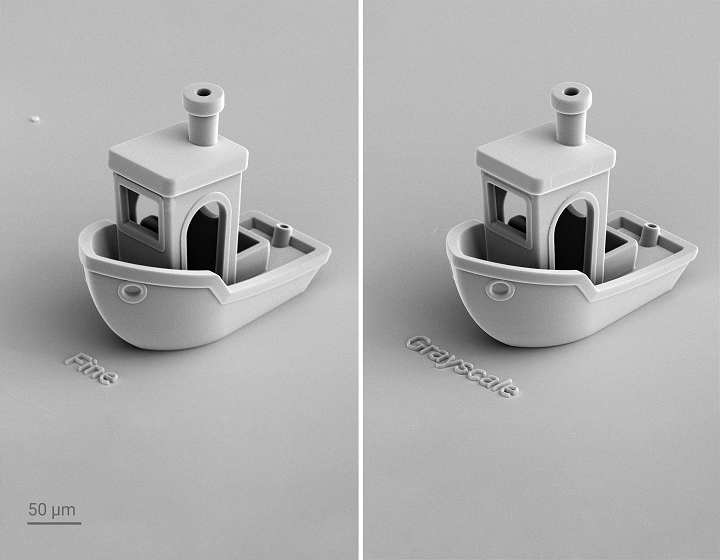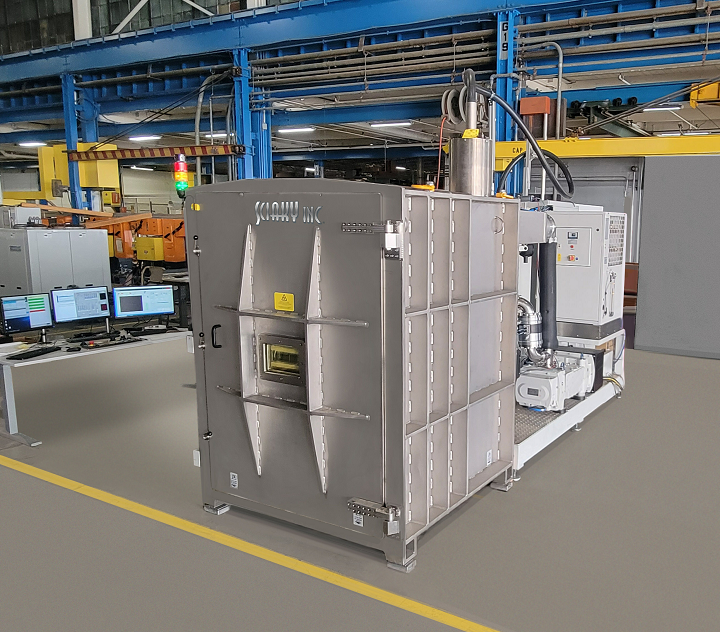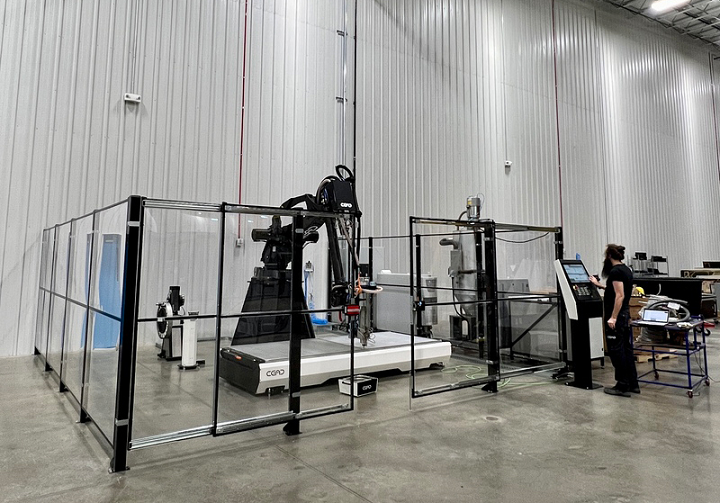In this Christmas Eve edition of 3D Printing News Briefs, we’re starting with EBAM, DLS, and Two-Photon Grayscale Lithography (2GL) 3D printing news. Moving on, Airtech Advanced Materials Group is partnering with CEAD, which recently expanded its U.S. footprint, and Madco3D is printing parts of a high-rise building. Finally, there’s some interesting research out of Fraunhofer IWU about 3D printed load-bearing plastic structures.
Sciaky Announced EBAM-53 for Researchers & Laboratories
Electron beam welding and metal 3D printing solutions provider Sciaky Inc., a subsidiary of Phillips Service Industries, has announced its EBAM-53 Machine for Laboratory and Research Facilities. It’s meant specifically for users who are researching on a smaller scale, but plan to use a larger Sciaky EBAM (Electron Beam Additive Manufacturing) system in the future. EBAM technology uses wire feedstock to create intricate internal structures and consolidated assemblies, and allows engineers to optimize part performance and reduce weight in a way that traditional manufacturing methods can’t achieve. The EBAM-53 is perfect for materials research laboratory and R&D settings: it costs less and has a smaller build envelope of a 26 inch cube, so there’s less of a space requirement. It can manufacture test coupons, small demonstrators, and geometry trial parts, and features IRISS process control software, with optional rotary and tilt positioners.
“This has been a goal of Sciaky for years. We have been asked numerous times to offer a system appropriate for a research environment. We can now answer this part of the industry’s demand. With the EBAM-53, users can conduct meaningful research and development that can easily migrate to larger production-scale systems in the future,” said Scott Phillips, President at Sciaky, Inc.
Fictiv Added Carbon DLS Technology to 3D Printing Service

Carbon DLS resins have advanced mechanical properties, such as the high temperature resistance of the material CE 221 shown here.
Following a major 3D printing service expansion in the U.S. to offer more industrial additive solutions for advanced engineering and high-volume production applications, Fictiv has added Digital Light Synthesis (DLS) technology by Carbon to its on-demand 3D printing services in the country. The company is the operating system (OS) for custom manufacturing, and has manufactured more than 25 million parts for early-stage companies and large enterprises. DLS is good for end-use production and prototyping for many industries, including aerospace, automotive, consumer products, and medical, and will definitely strengthen Fictiv’s digital manufacturing platform. Carbon’s continuous liquid interface production (CLIP) technology enables rapid print speeds, and the solution also ensures high print accuracy and repeatability. It’s now available on Fictiv’s platform for on-demand ordering, instant quoting, and design for manufacturability feedback; materials include proprietary Carbon resins with advanced engineering properties.
“The trend of using 3D printing to manufacture functional, end-use parts is on the rise. The addition of Carbon DLS to the Fictiv platform makes it faster and easier than ever for our customers to go from prototype design to market-ready products through a single manufacturing partner,” said Riley Hall, Director of Additive at Fictiv.
Nanoscribe Introduced 2GL 3D Printing for Nano- & Microfabrication

Speed comparison of a Benchy boat 3D printed with a very competitive 2PP system (left) and with 3D printing by 2GL (right). To obtain the highest possible print quality, the slicing distance of the 2PP printed boat is set to 0.1 µm (“Fine”). In contrast, the same object is 3D printed by 2GL (“Grayscale”) with a significantly coarser slicing of 1 µm, resulting in a print time reduced by a factor of 10.
Karlsruhe Institute of Technology (KIT) spinoff Nanoscribe, a BICO company, has introduced a new microfabrication technology for its Quantum X align: 3D printing by 2GL, or two-photon grayscale lithography. It combines high-resolution 2PP (two-photon polymerization) with a patented voxel tuning process to achieve superior print quality, significantly fewer printing layers, and increased throughput—all of which combine to make 2GL the fastest 2PP-based 3D printing technology. The solution can open the door for new applications, like manufacturing filigree micro-optical systems with much higher quality and reduced print times. Nanscribe’s Quantum X platform is a preferred solution for industrial manufacturing of microoptics, which is why 3D printing by 2GL is now available as a new feature for the Quantum X align, supported by its advanced nanoPrintX aligner software.
This printing process uses dynamic modulation of laser power in real time while scanning at high speeds, which results in what Nanoscribe says is a “precise size adjustment of the polymerizing voxel to perfectly match the contours of any 3D shape” and optical-grade, flawless surfaces. It’s also said to be the fastest 2PP-based microfabrication technology on the market, with up to 60 times the throughput of other current two-photon lithography system, and the technology enables fine submicron features and the highest optical-grade quality. All of this combined allows 3D printing by 2GL to advance microoptics manufacturing and photonics packaging.
Airtech Advanced Materials Group Improved AM Capabilities with CEAD
Airtech Advanced Materials Group recently integrated Flexbot systems from new partner CEAD into its advanced manufacturing portfolio, significantly advancing its additive manufacturing capabilities. Flexbot is a robotic large-format 3D printing solution by CEAD, which recently expanded its footprint in the U.S. in order to enhance client support by launching CEAD Group Inc. in Detroit, Michigan. The Flexbot, which is now located in Airtech’s Additive Manufacturing Center of Excellence in Tennessee, features CNC milling capabilities, Dynamic Flow Control, and a 3 x 1 m build volume, and will be used by Airtech to develop 3D printing resins and explore new applications in diverse market segments.
“CEAD’s industry-leading, fully integrated, robotic printing and milling hybrid solution equips Airtech to support its continued growth in the additive manufacturing market segment, providing unparalleled support for CEAD and Airtech customers worldwide,” said Gregory Haye, Director of Additive Manufacturing at Airtech, about the company’s important addition.
Madco3D Printing Parts of Brooklyn High-Rise
NYC-based startup Madco3D, currently in a pre-revenue stage of business development, is developing robotic, autonomous, mega-scale 3D printing systems, in addition to design and build services, for construction applications. The architect-led company wants to help redefine the construction paradigm, restore the coastal marine environment, and help solve the housing crisis, all with its 3D concrete printing (3DCP) technology. Madco3D is partnering with investors and commercial developers, and launched a test site, complete with its large-scale 3D printer, in the Northeastern U.S. The startup’s technology has the potential to be used for applications in coral restoration, infrastructure like bridges and dams, seawall development, disaster housing, custom artwork, urban projects like park benches, commercial construction, and housing…like a high-rise in New York City.
“In just this year, we have received an influx of significant development projects in the pipeline—requests for over 100 homes in New Hampshire alone, and we will be printing one of the first-ever high-rises in New York City (or the U.S.A.) to incorporate 3d-printed concrete features. Madco aims to achieve 15% faster schedules, 3x reduction in labor, 10% cost savings, 20% net profit margin, and a reduced carbon footprint.”
Fraunhofer IWU 3D Printing Load-Bearing Plastic Structures

Dyna Light Project: Load-bearing frame construction for the electric cargo scooter from a 3D printer. (Source: Fraunhofer IWU)
Even in closed material cycles, it’s possible to design, and economically produce, highly durable products using granulate-based plastic manufacturing processes, such as 3D printing. Researchers from Fraunhofer Institute for Machine Tools and Forming Technology (Fraunhofer IWU) demonstrated how Screw Extrusion Additive Manufacturing, or SEAM, was used to fabricate two load-bearing plastic structures: a resilient vehicle frame and an EV cargo shelf. Developed at Fraunhofer IWU, the SEAM process is said to be eight times faster than conventional 3D printing, and is also much more economical than extrusion-based methods that use filament, as it processes cost-effective plastic granulates. Plus, it contributes to a circular economy by using granules from recycled thermoplastics.
CO2 emissions in the transportation sector are significantly reduced in battery EV vehicles, but these need to be more lightweight, as heavy high-voltage systems unfortunately come “at the expense of allowable payload.” Fraunhofer IWU partnered with Mosolf Special Vehicles on a solution to optimize cargo space and reduce weight at the same time: a 3D printed rear shelf, which can hold up to 100 kg. It fits right into the vehicle’s exterior, with no additional attachments or reinforcements, and provides an 8% enlarged storage area. Additionally, electric cargo scooters can also help reduce emissions, and extra payload capacity is enabled with weight optimization, but safety must remain paramount. The designers of the Innvelo Cargo-Scooter, from ICM Chemnitz, first used a steel frame, but its partners in the Dyna Light project—including Fraunhofer IWU and Sauer Creations—suggested a 3D printed plastic one instead. Made with SEAM technology, it saves about 10% in costs and weight, and can still support a total payload capacity of about 200 kg, including the rider.
Subscribe to Our Email Newsletter
Stay up-to-date on all the latest news from the 3D printing industry and receive information and offers from third party vendors.
You May Also Like
Further Understanding of 3D Printing Design at ADDITIV Design World
ADDITIV is back once again! This time, the virtual platform for additive manufacturing will be holding the first-ever edition of ADDITIV Design World on May 23rd from 9:00 AM –...
3D Printer Maker EVO-tech Reborn as NEVO3D — Once More With Feeling
EVO-tech was a 3D printing service and original equipment manufacturer established in 2013 and based in Schörfling am Attersee, Austria. The company produced high-quality material extrusion systems featuring linear bearings,...
3D Systems Brings 3D Printed PEEK Cranial Implant to the U.S. with FDA Clearance
For more than 10 years, 3D Systems (NYSE:DDD) has worked hand-in-hand with surgeons to plan over 150,000 patient-specific cases, and develop more than two million instruments and implants from its...
CDFAM Returns to Berlin for Second Annual Symposium
The second CDFAM Computational Design Symposium is scheduled for May 7-8, 2024, in Berlin, and will convene leading experts in computational design across all scales. Building upon the first event...


































